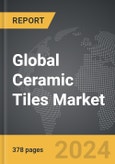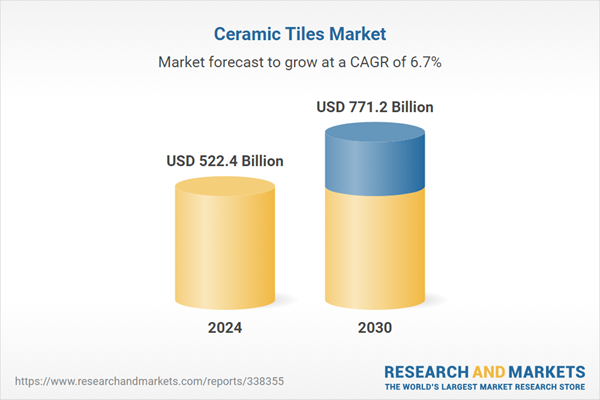The global market for Ceramic Tiles was valued at US$522.4 Billion in 2024 and is projected to reach US$771.2 Billion by 2030, growing at a CAGR of 6.7% from 2024 to 2030. This comprehensive report provides an in-depth analysis of market trends, drivers, and forecasts, helping you make informed business decisions. The report includes the most recent global tariff developments and how they impact the Ceramic Tiles market.
Segments: Product Type (Porcelain, Glazed, Scratch Free, Other Product Types); Application (Floor, Wall, Other Applications).
Geographic Regions/Countries: World; United States; Canada; Japan; China; Europe (France; Germany; Italy; United Kingdom; Spain; Russia; and Rest of Europe); Asia-Pacific (Australia; India; South Korea; and Rest of Asia-Pacific); Latin America (Argentina; Brazil; Mexico; and Rest of Latin America); Middle East (Iran; Israel; Saudi Arabia; United Arab Emirates; and Rest of Middle East); and Africa.
The analysts continuously track trade developments worldwide, drawing insights from leading global economists and over 200 industry and policy institutions, including think tanks, trade organizations, and national economic advisory bodies. This intelligence is integrated into forecasting models to provide timely, data-driven analysis of emerging risks and opportunities.
Global Ceramic Tiles Market - Key Trends and Drivers Summarized
Why Are Ceramic Tiles a Staple in Modern Architecture and Design?
Ceramic tiles have long been celebrated for their aesthetic versatility and functional resilience, making them a staple in both residential and commercial construction. Originating thousands of years ago, ceramic tiles continue to be a popular choice due to their durability, low maintenance, and resistance to stains and moisture. Composed of natural materials like clay, sand, and water, these tiles are formed under high heat to create a hard surface that can be glazed with various colors and patterns. Their ability to maintain coolness in hot climates also adds to their appeal in a wide range of geographical locations. In contemporary architecture, ceramic tiles are used not just for their practicality but also for their ability to enhance the decor, embodying both traditional and modern design trends through endless customization options.How Have Advances in Technology Transformed Ceramic Tile Production?
Technological advancements have significantly transformed the production of ceramic tiles, enhancing both their quality and the efficiency of their manufacturing processes. Digital printing technologies have revolutionized tile decoration, allowing for more intricate and precise designs, including realistic reproductions of natural materials like wood, stone, and marble. This technology not only expands design capabilities but also reduces waste during the production phase, as patterns can be printed directly onto the tile, minimizing the use of materials. Additionally, innovations in kiln technology have improved energy efficiency and control over firing temperatures, which enhances the strength and consistency of the final product. These technological improvements have enabled manufacturers to meet increasing consumer demands for high-quality, aesthetically pleasing tiles that are both durable and environmentally sustainable.What Role Do Ceramic Tiles Play in Sustainable Building Practices?
Ceramic tiles contribute significantly to sustainable building practices due to their long lifespan and eco-friendly properties. They are a key component in green building certifications like LEED and BREEAM, which evaluate materials based on their environmental impact. Ceramic tiles are inherently free of volatile organic compounds (VOCs) and allergens, making them a safe and sustainable choice for indoor environments. Moreover, their thermal mass helps regulate indoor temperatures, reducing the need for artificial heating and cooling, thus conserving energy. The industry is also moving towards more sustainable practices, including the use of recycled materials in tile production and the development of more efficient recycling processes for post-consumer ceramic waste. These efforts not only enhance the environmental credentials of ceramic tiles but also appeal to a growing demographic of eco-conscious consumers.What Drives the Growth in the Ceramic Tiles Market?
The growth in the ceramic tiles market is driven by several factors, reflecting a blend of technological, economic, and consumer trends. Urbanization and rising global income levels have expanded the construction sector, increasing the demand for ceramic tiles in new buildings and renovations. Technological advancements that improve the aesthetic appeal and functionality of ceramic tiles, such as digital printing and improved material properties, have broadened their application in both residential and commercial spaces. Additionally, the shift towards sustainable building materials has positioned ceramic tiles as a preferred option for eco-friendly construction projects. Consumer preferences for durable, low-maintenance, and aesthetically diverse flooring and wall covering solutions further fuel demand. Furthermore, the global nature of the market, with significant production hubs in Italy, Spain, China, and India, facilitates a steady flow of innovations and competitive pricing, making ceramic tiles accessible and appealing to a broad international audience. These factors collectively drive robust growth in the ceramic tiles market, underscoring their enduring appeal and versatility.Report Scope
The report analyzes the Ceramic Tiles market, presented in terms of units. The analysis covers the key segments and geographic regions outlined below.Segments: Product Type (Porcelain, Glazed, Scratch Free, Other Product Types); Application (Floor, Wall, Other Applications).
Geographic Regions/Countries: World; United States; Canada; Japan; China; Europe (France; Germany; Italy; United Kingdom; Spain; Russia; and Rest of Europe); Asia-Pacific (Australia; India; South Korea; and Rest of Asia-Pacific); Latin America (Argentina; Brazil; Mexico; and Rest of Latin America); Middle East (Iran; Israel; Saudi Arabia; United Arab Emirates; and Rest of Middle East); and Africa.
Key Insights:
- Market Growth: Understand the significant growth trajectory of the Porcelain Tiles segment, which is expected to reach US$417.8 Billion by 2030 with a CAGR of a 7.7%. The Glazed Tiles segment is also set to grow at 5.4% CAGR over the analysis period.
- Regional Analysis: Gain insights into the U.S. market, valued at $136.4 Billion in 2024, and China, forecasted to grow at an impressive 9.9% CAGR to reach $179.0 Billion by 2030. Discover growth trends in other key regions, including Japan, Canada, Germany, and the Asia-Pacific.
Why You Should Buy This Report:
- Detailed Market Analysis: Access a thorough analysis of the Global Ceramic Tiles Market, covering all major geographic regions and market segments.
- Competitive Insights: Get an overview of the competitive landscape, including the market presence of major players across different geographies.
- Future Trends and Drivers: Understand the key trends and drivers shaping the future of the Global Ceramic Tiles Market.
- Actionable Insights: Benefit from actionable insights that can help you identify new revenue opportunities and make strategic business decisions.
Key Questions Answered:
- How is the Global Ceramic Tiles Market expected to evolve by 2030?
- What are the main drivers and restraints affecting the market?
- Which market segments will grow the most over the forecast period?
- How will market shares for different regions and segments change by 2030?
- Who are the leading players in the market, and what are their prospects?
Report Features:
- Comprehensive Market Data: Independent analysis of annual sales and market forecasts in US$ Million from 2024 to 2030.
- In-Depth Regional Analysis: Detailed insights into key markets, including the U.S., China, Japan, Canada, Europe, Asia-Pacific, Latin America, Middle East, and Africa.
- Company Profiles: Coverage of players such as Cerâmica Carmelo Fior, Clayhaus Ceramics, Crossville, Inc., Dongpeng, Dynasty Ceramic Public Company and more.
- Complimentary Updates: Receive free report updates for one year to keep you informed of the latest market developments.
Some of the 252 companies featured in this Ceramic Tiles market report include:
- Cerâmica Carmelo Fior
- Clayhaus Ceramics
- Crossville, Inc.
- Dongpeng
- Dynasty Ceramic Public Company
- Grupo Cedasa
- Grupo Fragnani
- Gruppo Concorde S.p.A.
- H & R Johnson
- Johnson Tiles Limited
- Kajaria Ceramics Ltd.
- Lamosa Revestimientos S.A. de C.V.
- Lasselsberger GmbH
- Marazzi Group S.p.A.
- Mohawk Industries
- Mulia, Inc.
- Pamesa Ceramica SL
- RAK Ceramics Co.,
- Rovese S.A.
- Saudi Ceramic Company
- The Celima (Trebol Group)
- The Siam Cement Public Company Limited
- White Horse Ceramic Industries Sdn Bhd.
Tariff Impact Analysis: Key Insights for 2025
Global tariff negotiations across 180+ countries are reshaping supply chains, costs, and competitiveness. This report reflects the latest developments as of April 2025 and incorporates forward-looking insights into the market outlook.The analysts continuously track trade developments worldwide, drawing insights from leading global economists and over 200 industry and policy institutions, including think tanks, trade organizations, and national economic advisory bodies. This intelligence is integrated into forecasting models to provide timely, data-driven analysis of emerging risks and opportunities.
What’s Included in This Edition:
- Tariff-adjusted market forecasts by region and segment
- Analysis of cost and supply chain implications by sourcing and trade exposure
- Strategic insights into geographic shifts
Buyers receive a free July 2025 update with:
- Finalized tariff impacts and new trade agreement effects
- Updated projections reflecting global sourcing and cost shifts
- Expanded country-specific coverage across the industry
Table of Contents
I. METHODOLOGYII. EXECUTIVE SUMMARY2. FOCUS ON SELECT PLAYERSIII. MARKET ANALYSISSOUTH KOREAREST OF ASIA-PACIFICARGENTINABRAZILMEXICOREST OF LATIN AMERICAIRANISRAELSAUDI ARABIAUNITED ARAB EMIRATESREST OF MIDDLE EASTIV. COMPETITION
1. MARKET OVERVIEW
3. MARKET TRENDS & DRIVERS
4. GLOBAL MARKET PERSPECTIVE
UNITED STATES
CANADA
JAPAN
CHINA
EUROPE
FRANCE
GERMANY
ITALY
UNITED KINGDOM
SPAIN
RUSSIA
REST OF EUROPE
ASIA-PACIFIC
AUSTRALIA
INDIA
LATIN AMERICA
MIDDLE EAST
AFRICA
Companies Mentioned (Partial List)
A selection of companies mentioned in this report includes, but is not limited to:
- Cerâmica Carmelo Fior
- Clayhaus Ceramics
- Crossville, Inc.
- Dongpeng
- Dynasty Ceramic Public Company
- Grupo Cedasa
- Grupo Fragnani
- Gruppo Concorde S.p.A.
- H & R Johnson
- Johnson Tiles Limited
- Kajaria Ceramics Ltd.
- Lamosa Revestimientos S.A. de C.V.
- Lasselsberger GmbH
- Marazzi Group S.p.A.
- Mohawk Industries
- Mulia, Inc.
- Pamesa Ceramica SL
- RAK Ceramics Co.,
- Rovese S.A.
- Saudi Ceramic Company
- The Celima (Trebol Group)
- The Siam Cement Public Company Limited
- White Horse Ceramic Industries Sdn Bhd.
Table Information
| Report Attribute | Details |
|---|---|
| No. of Pages | 378 |
| Published | April 2025 |
| Forecast Period | 2024 - 2030 |
| Estimated Market Value ( USD | $ 522.4 Billion |
| Forecasted Market Value ( USD | $ 771.2 Billion |
| Compound Annual Growth Rate | 6.7% |
| Regions Covered | Global |









